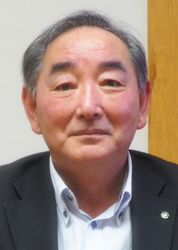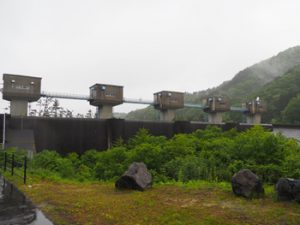Series ”Visiting the village” in search of the key to regional revitalization 12 Fudai Village, Iwate Prefecture

柾屋伸夫村長(Mayor Nobuo Masuya)
Fudai Village is experiencing a rapid outflow of young women, and it is estimated that by 2050, the number of young women will be 30. The village sees this situation as its biggest challenge, and is working with neighboring municipalities to find ways to stop the outflow of young people. (Kitajima Kei)
Fudai Village is a village facing the Pacific Ocean in the northeastern part of Iwate Prefecture. It has a population of about 2,400 people. The aging rate is about 45%. It is the smallest municipality in the prefecture. There are 26 municipalities in the prefecture, about 80% of which are at risk of disappearing, and Fudai Village, one of these, is estimated to have a young female population (20-39 years old) of 30 people in 2050. Mayor Masuya Nobuo said, “I recognize that population outflow is the biggest issue. We are focusing on reducing the burden on young people through child-rearing policies and other measures, but young people inevitably move to Tokyo and Sendai. Women in particular tend not to return once they leave the village for school or work.” He folded his arms and said.
Now, with the construction of the free Sanriku Coastal Highway, commuting has become more convenient, and Miyako City and Hachinohe City are within commuting distance.
“We want to promote the ease of commuting outside the village, and increase the number of young people who live in Fudai, which has many benefits for raising children, and commute to work outside the village. At present, we are working with neighboring municipalities to attract jobs that women want to take,” said Mayor Masuya.
Fudai is adjacent to Noda Village and Tanohata Village. An area with three villages connected is rare nationwide. Kunohe Village is also close, although it is a little far away.
At present, they are trying to attract companies to the three villages along the Sanriku Railway line: Fudai Village, Noda Village, and Tanohata Village. In addition, the four villages, including Kunohe, sometimes hold joint events.
“In terms of local government cooperation, Fudai, Noda, Tanohata, and Otsuchi use the same local government cloud. This is an initiative as local governments that suffered damage from the tsunami in the Great East Japan Earthquake. Local government cooperation is gradually expanding,” says Mayor Masuya.

断崖絶壁を眺めることができるトレイル。海外の注
目度も高い(A trail where you can see the cliffs. It is also attracting a lot of attention from overseas)
Digital transformation in Fudai has just begun. Since April, employees from a Tokyo-based IT company have been seconded to the town hall to hear about the situation at the town hall and determine what digital transformation is needed.
In terms of industry, various issues have become apparent, including a labor shortage, and they are trying to see if digital transformation can cover these issues. Fudai’s main industry is fishing. Seaweed and kelp are cultivated in the open ocean, but the labor shortage is becoming serious in the first stage of processing after the catch is landed.
“It would be nice if we could cover these issues with DX, but since this is a job that involves dealing with nature, it is difficult to cover them completely. For example, we may be able to use DX partially to supplement the inspection of foreign objects mixed in with wakame seaweed and kombu, and reduce the labor required,” said Mayor Masuya.
Incidentally, in recent years, the sea around Fudai village has also been changing due to the effects of climate change.
In the past, autumn salmon was often caught. It was a large fish that contained salmon roe and sold for a high price, but now only about 10% of the autumn salmon that was caught before, and instead, sardines and mackerel have increased. However, the unit price is low and it is only about 10% of the autumn salmon.
Although sardines and mackerel can now be caught about seven times as much as before, it is becoming more difficult to make a profit.
Prices of fish vary depending on their size. Currently, size measurement is done manually, but if DX can be used to reduce the labor required, profits may increase accordingly.
In terms of tourism, the nature trail “Michinoku Sea Breeze Trail” will be put forward as a priority. The trails in Fudai Village offer views of the sheer cliffs that are unique to ria coastlines. After being featured in the British daily newspaper The Times as a scenic spot, the village has attracted attention and is now attracting more inbound tourists.
In order to accommodate foreign tourists, staff use AI translation machines to communicate with them.

普代水門。東日本大震災の大津波を食い止めた「奇跡の水門」として有名(The Fudai floodgate is famous as the “miracle floodgate” that stopped the tsunami caused by the Great East Japan Earthquake.)
Fudai Village was hit by the fury of a giant tsunami during the Great East Japan Earthquake. However, there were no casualties or damage to homes. It seems like a miracle, but what saved the village was the 15.5-meter-tall Fudai Floodgate, which stopped the 23.6-meter tsunami.
The Fudai Floodgate is still fondly known to local residents as the “miracle floodgate.” A picture book titled “The Miracle Floodgate that Saved Fudai Village” has also been published, which clearly describes the circumstances surrounding the floodgate’s creation, its role, and the situation during the Great East Japan Earthquake.
Mayor Masuya said, “New damage estimates have been issued, and the area around the town hall has been designated a flood zone. We will do our best to ensure thorough evacuation. If a disaster occurs, people will evacuate to large public facilities such as schools. That is why we have decided to relocate schools that are in flood zones to higher ground.”
Design is scheduled to be completed in October this year, and construction will begin next year over a two-year period.
※Translating Japanese articles into English with AI
